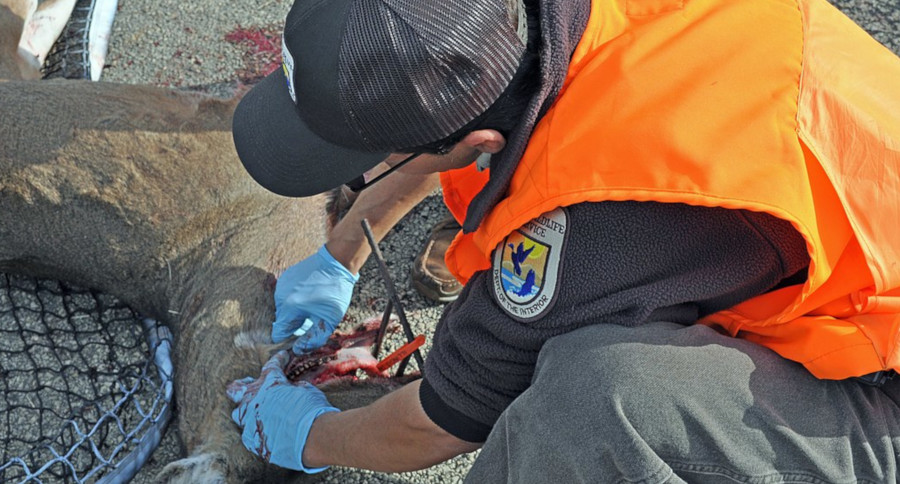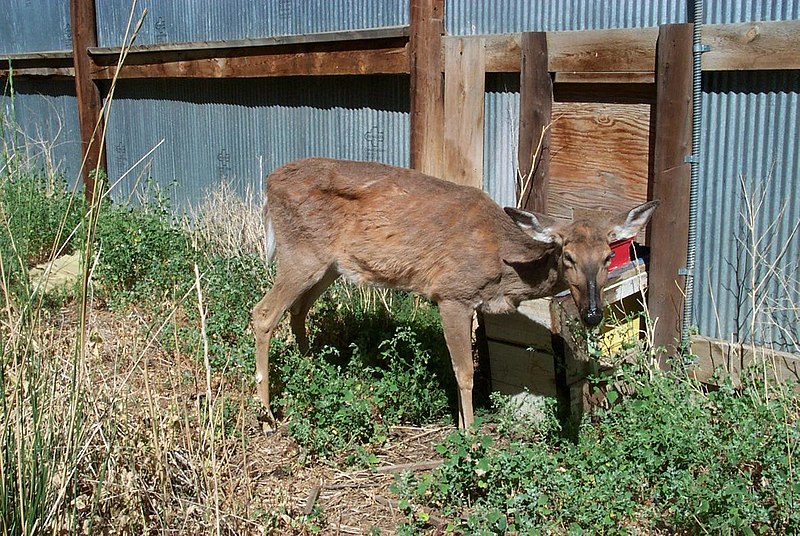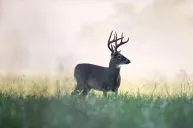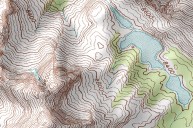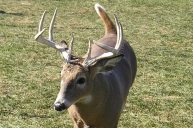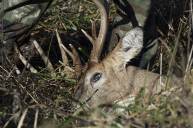The world is not going to end in CWD-induced madness.
I really shouldn't have to write this article. Yet, here we are. Earlier this week my social media feeds lit up like a Christmas tree with people freaking out over a "zombie deer disease."
I groaned. I knew exactly what it was going to be, and I knew people were being induced into a panic for nothing. The "zombie disease" was nothing of the sort. It was chronic wasting disease.
It's not like CWD is unknown. I've been writing about this disease for almost five years now. The disease was first observed in captive mule deer in Colorado back in the 1960s. Even then, it wasn't until 1978 that it was officially classified and given the name "CWD."
So, why the sudden panic? My best guess is our current political climate has everyone just a bit on edge right now. When someone suggests a humanity-ending disease is real, everyone just freaks the hell out.
It probably didn't help that many news organizations were running that clip from the Korean zombie movie "Train to Busan" where a wild deer actually becomes "zombified."
Great movie, but I'm here to tell you, if CWD were to become a legitimate threat to the public health of humans, we would have already known.
What is CWD?
First off, CWD exclusively affects members of the deer family. This includes elk and moose. Scientists have seen the unique prion-based disease jump the species barrier in lab testing, but there has yet to be a confirmed case outside of controlled scientific experiments.
What is a prion disease you may ask? Well, let's quote the Centers for Disease Control directly here, because it's a mouthful to explain:
"Prion diseases or transmissible spongiform encephalopathies (TSEs) are a family of rare progressive neurodegenerative disorders that affect both humans and animals. They are distinguished by long incubation periods, characteristic spongiform changes associated with neuronal loss, and a failure to induce inflammatory response.
The causative agents of TSEs are believed to be prions. The term "prions" refers to abnormal, pathogenic agents that are transmissible and are able to induce abnormal folding of specific normal cellular proteins called prion proteins that are found most abundantly in the brain," the CDC's website reads.
Simply put, it's a highly infectious neurological disorder, and it is always fatal. To date, there are confirmed cases of CWD in 24 states, from Wyoming to Texas, all the way south to Mississippi and north to Wisconsin. The Badger State in particular has had a difficult time with CWD. It has also been found in some Canadian provinces. CWD has even been reported outside of North America in Korea, Finland, and Norway.
The symptoms
I truly believe part of what fed this week's panic over the fatal disease was an association of CWD symptoms with how zombies act in the movies. Infected deer are often lethargic, and they can lose their fear of humans. I've even seen sad videos of animals with the disease walking around in circles.
CWD-positive deer often exhibit signs of extreme weight loss and excessive salivation, thus giving a "zombie-like" appearance. Maybe this why some of my fellow journalists, almost exclusively outside the outdoor media industry, started using that terminology.
But the disease takes a long time to incubate once it is in a host. Some deer die without ever exhibiting any clinical signs at all. Many a hunter has shot a deer only to have their harvest somewhat ruined when wildlife management officials break the bad news that their deer was infected.
Some deer develop tremors of the head. They often stop eating. Many become excessively thirsty. This is why, after many CWD outbreaks, dead deer can often be found near water sources.
One of the big problems with CWD is that the prion that causes the disease can linger on well after the animal is dead, sometimes for years. If a deer dies and decomposes, the prion can leech into the soil in a hypothetical ticking time bomb.
If, five years down the line, another deer eats a patch of grass where the CWD-infected animal was laying, it can potentially infect that new animal.
I'm willing to admit that detail of the disease is scary. A totally unseen and silent killer that can pass from animal to animal without anyone ever realizing makes me nervous. That's why wildlife officials have been taking this so seriously, and initiating extreme precautions in many states.
But the deer DO NOT get violent, and they certainly don't crave flesh like a Hollywood zombie would. It's media hyperbole at its worst, and I feel like many mainstream members of that fraternity couldn't bother with a little research. That's disappointing, but we're hoping you're able to see through it, and willing to learn more about what makes this disease serious enough to address, but not as apocalyptic as some may say it is.
Controlling CWD
Because the prions that cause CWD often hide out in the lymph nodes, brain, and spinal cord of the animal, it presents a problem for deer hunters when they're transporting a kill. A hunter can unwittingly transfer the disease over state lines, where it may or may not be disposed of correctly, and start infecting a brand-new deer herd. Pretty scary right?
That is why more and more states are introducing regulations to try and avoid this. Both transport restrictions and mandatory (or in some cases voluntary) testing have changed the way many in the United States go about their hunting season. Instead of taking a deer straight to a processor for sausage and steaks, or directly to their home taxidermist after an out-of-state hunt, countless sportsmen and women are now now forced to wait.
Hunters are required to bone out the portions of a deer's carcass that may contain the prion for a positive test. These are taken by the state agency and tested, a process that's not exactly cheap and takes two weeks or more.
I know a Michigan hunter who shot a big buck in Wisconsin this year, and he had to cut off the antlers and clean the skull cap completely of brain matter before he could bring it back to Michigan. These have become standard regulations for most CWD-positive states, and there are some harsh penalties for hunters who don't follow the law.
As research facilities continue to study the disease, many state agencies now set up CWD containment zones wherever the disease is discovered. One standard practice has been to ban baiting or feeding of deer, under the assumption that deer are close together while feeding on a small pile, and the disease can spread via saliva.
Other, more drastic actions have included the banning of hunting attractants that use natural deer urine because of fears a hunter could unwittingly spread the prions if they pour this type of attractant on the ground.
Deer farms have been hit especially hard by CWD regulations, and likely for good reason. It's often the close quarters of a deer farm that result in high levels of positive tests once it's found. The matter of escaped animals and improper quarantine procedures have made deer farming extremely susceptible to CWD's effects.
In many cases, officials discover the disease in a few dead deer, and end up having to make the tough decision to euthanize most, if not all, of the others to try and stop it from going any further.
In one specific incident, two bucks escaped a Wisconsin deer farm and then spent five months on the loose before being taken out by sharpshooters. The Wisconsin Department of Natural Resources has no way of knowing what effect their presence may have had on free-ranging wild deer as a result.
Owners of captive deer are getting hit with harsher fines and tighter restrictions, because it seems disease outbreaks are often centered on such facilities.
Keep in mind however, that most of these facilities, in the United States anyway, don't raise venison for food for public consumption. Most of it is destined for high-fence deer ranches or other deer breeding facilities and not meat markets, which makes the chances of CWD spreading throughout the public through store-bought meat quite unlikely indeed.
In my own conversations with a local specialty meat store that does sell venison, I found out most of their venison and other commercially-available venison comes from farm-raised deer in New Zealand, which thankfully, does not have any cases of CWD as of yet.
It is, in case you didn't know, still illegal to sell any harvested wild game meat in the United States. You're only allowed to consume what you hunt, catch, or trap, with very few exceptions.
Is CWD a threat to humans?
Simply put, no. Again, let me cite the CDC's website.
"To date, there have been no reported cases of CWD infection in people."
That being said, back in the late 1990s, there were three cases of Creutzfelt-Jakob Disease or CJD in humans who had eaten venison. This was serious enough that the World Health Organization decided to look at a link between CWD and CJD, because CJD is also a rare prion disease, and one known to affect humans.
Ultimately, their research into the subject couldn't find a link between these cases and CWD.
A few years ago some scientists did get CWD to jump the species barrier to monkeys, but it happened under controlled testing, and only after the monkeys ate contaminated meat. CWD has a ways to go before it hits "zombie apocalypse" proportions.
If the World Health Organization isn't panicking, I don't think the public should be either. That being said, they do advise caution to hunters. We're not trying to say you shouldn't have deer tested for the disease, or that you can safely consume the meat of an animal that is CWD-positive. That would be foolish, as would eating a deer you knew to have any other disease. If the capabilities have been reached and some patience can be maintained, there are absolutely no reasons to disobey the regulations that wildlife experts have helped put into place.
Take the precautions necessary for a safe harvest, and you'll be doing your part to help reach an end to the spread and contamination of CWD.
The disease remains rare from an overall perspective. Here in my home state of Michigan there are about 1.5 million deer. Only about 100 total suspected cases of CWD have ever been found here to date. The odds of catching it are mathematically low.
If it's a zombie apocalypse, it's moving even slower than the zombies in George Romero's original "Night of the Living Dead."
Stop the silliness
https://www.youtube.com/watch?v=JRL9MSIaybY
Earlier this week a video popped up on my YouTube recommendations that explained how "How CWD Could Become the True Zombie Apocalypse." My eyes rolled so hard they nearly fell out of my head. (I found even more ridiculous titles on YouTube videos as I was putting together this article.)
Odds are, someone at some point, has unknowingly eaten venison of an animal that was CWD-positive. There are too many hunters and the disease has become too wide-spread for it to not have happened by accident by now. If it was going to turn humans into ravenous, violent flesh-eaters, we think it would have happened already. Even if it did make the jump to humans, it would have to start with someone who has eaten the meat of an infected animal. I'm not even sure why vegans are freaking in this case.
Even if theoretically, a hunter did become infected with CWD from a deer, remember the long incubation period of the disease. We're betting if news of a human getting infected with CWD hits, a lot of freezers in the surrounding area would be emptied of venison before many more people could get infected. It would likely happen whether the deer that provided that venison tested positive or not.
Again, keep in mind we're not trying to say you should eat venison infected with CWD, because you shouldn't! Nor are we trying to downplay the severity of CWD. You should be concerned, especially if you're a deer hunter.
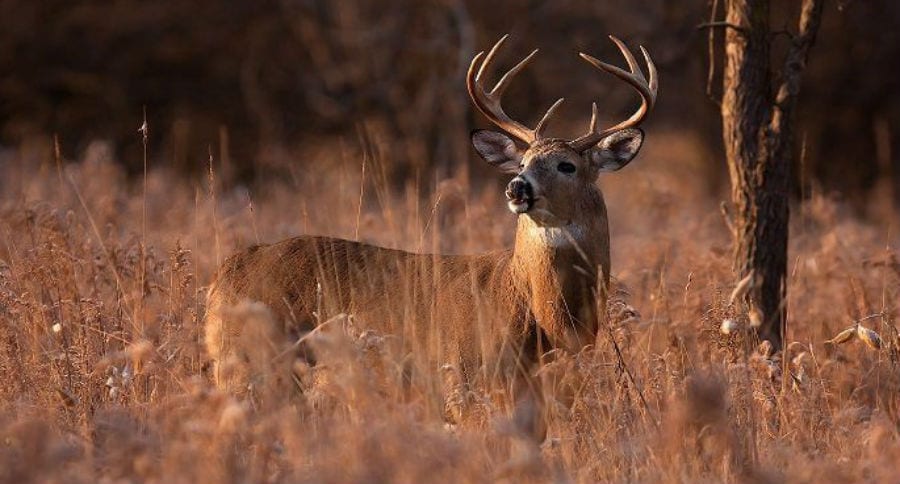
CWD isn't good for any deer, elk, or moose herd. All hunters should be aware of how it spreads, and they should take steps to avoid facilitating that spread whenever possible. That means taking your deer in to have them tested for the disease if authorities say it is necessary.
Even if your area has no history of the disease, it's still not a bad idea if you want to be certain your venison is safe. You might help authorities catch an outbreak before it spreads. You can also help by making sure you're following local regulations if you are bringing in an animal from CWD-positive state to one where the disease has yet to rear its ugly head.
Odds are, if the disease does ever make the jump to humans, it will be quickly contained and isolated before it can spread to large masses of people. Could an infectious disease potentially threaten humanity one day? Sure. Remember, the Black Plague killed an estimated 200 million people in the 1300s. If something like that has happened once, it can certainly happen again.
But we have a hard time believing CWD will be the disease to do it. It's been around far too long, and it's being diligently covered by the scientific community. Keep in mind, it certainly hasn't wiped deer, elk, or moose off the face of the earth yet, so I'm betting humans will be okay.
There are no known cases of CWD infecting humans. And even if it did infect humans, the disease spreads way too slowly to suddenly plunge humanity into "Mad Max" post-apocalyptic times. To suggest otherwise is completely absurd, irresponsible and does nothing more than to rile people into an unnecessary panic.
For more outdoor content from Travis Smola, be sure to follow him on Twitter and check out his Geocaching and Outdoors with Travis Youtube channels.
NEXT: ANOTHER CAPTIVE DEER HAS TESTED POSITIVE FOR CWD IN WISCONSIN
WATCH
